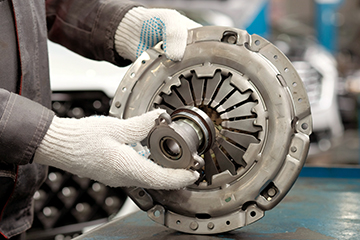Your Clutch: The Heart of Manual Transmissions
Do you drive a vehicle with a manual transmission? If so, then you have a pretty good idea that the is a critical element in the operation of a manual car. It allows you to smoothly shift gears and control the power delivered from the engine to the wheels. The experts at Meineke in Harrisburg on Jonestown Road dive into the inner workings of a clutch to discover how it operates and why it's so important in manual transmissions.
The Basics
A clutch is basically a device that connects and disconnects the engine's power from the transmission and ultimately the wheels. This connection and disconnection are what enable the driver to change gears, come to a stop, and start moving again without turning off the engine. Here's how it works:
- Clutch Disc: The heart of the clutch system is the clutch disc. It's a friction material disc, similar to a brake pad but designed for a different purpose. The clutch disc is sandwiched between the flywheel (attached to the engine) and the pressure plate (attached to the transmission).
- Flywheel: The flywheel is a heavy, rotating disk bolted to the engine's crankshaft. Its purpose is to store rotational energy from the engine and provide a smooth surface for the clutch disc to make contact with.
- Pressure Plate: The pressure plate is mounted on the transmission's input shaft and pushes against the clutch disc. When it presses against the clutch disc, it forces it to engage with the flywheel, creating a connection between the engine and the transmission.
- Clutch Pedal: The driver controls the clutch through the clutch pedal in the cabin. When the clutch pedal is depressed, it disengages the clutch, separating the clutch disc from the flywheel. Releasing the pedal re-engages the clutch, connecting the engine to the transmission.
And We're Off and Running... Step by step:
- Starting the Engine: When you start your car, the engine's crankshaft begins to spin, turning the flywheel with it.
- Clutch Pedal Depressed: When you press the clutch pedal, the pressure plate moves away from the clutch disc, creating a gap between them. This gap effectively disconnects the engine's power from the transmission.
- Shifting Gears: While the clutch is disengaged, you can shift gears using the gear lever. Without the clutch, you'd hear grinding noises, and the transmission wouldn't allow smooth gear changes.
- Releasing the Clutch Pedal: When you release the clutch pedal gradually, the pressure plate pushes the clutch disc against the spinning flywheel. Friction between the clutch disc and flywheel allows the transmission to connect with the engine's power.
- Power Transfer: As the clutch engages, power from the engine is transferred through the transmission and into the wheels, propelling the vehicle forward.
Now you know...
The clutch is the interface between the engine and the transmission, allowing you to control the flow of power to the wheels and navigate the road with precision. Whether you're shifting gears or simply pulling away from a stoplight, the clutch is the unsung hero of manual driving. For more detailed information on How a Car Clutch Works, check out the How A Car Works site. And, for the care and maintenance of your clutch (and all your vehicle needs) check out Meineke in Harrisburg on Jonestown Road. If the Harrisburg location is inconvenient, you can get the same top-quality service at any of the other 12 Meineke Car Care Centers in South Central Pennsylvania.
MEINEKE CAR CARE | LOCAL CAR CARE | LOCAL MECHANIC | HARRISBURG CAR CARE | HARRISBURG AUTO CARE | CAR CARE NEAR ME | OIL CHANGE NEAR ME | ASE CERTIFIED | EV CARE | EV BATTERY | CLUTCH
#MEINEKECARCARE #LOCALCARCARE #HarrisburgCarCare #HarrisburgAUTOCARE #CarCareNearMe #MeinekeCares #Meineke #OilChangeNearMe #OilChange #ASEcertified #Diagnositics #EV #EVbattery #UsedCarRepair #Clutch


